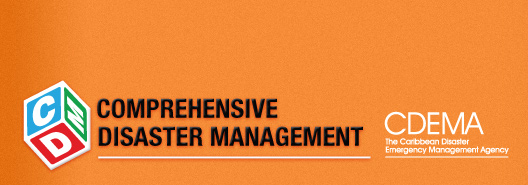|
Why Prepare a Disaster Plan?
The Caribbean is vulnerable to the effects of many hazards. We’re directly in the path of hurricanes, earthquakes, tsunamis – many of us live with volcanoes at our backdoors. This doesn’t mean that we should live in constant fear nor does it mean we should be too relaxed. Instead, we should prepare ourselves so that when disaster does strike, we will reduce the damage it can do to us.
Before, during and after a hazard, it’s obvious that your first concern will be for your family, your home and possessions. You may not have considered questions like:
Where will you be during a disaster? Will you be at home? Where will your family be? Will you be able to find them?
This is why it is so important to create a Family Disaster Plan. These questions can be answered beforehand so that during a disaster, you will be prepared.
How do I Prepare a Disaster Plan?
Step One – Learn as much as you can.
The first step is research. Do not wait until a disaster is coming to find important information. This step is incredibly important for your plan – here are some things you should find out:
- What hazards are you exposed to? Do you live near to the ocean or rivers? Are you near to a volcano? The type of hazard you’re exposed to will determine the way you prepare yourself.
- Find out about disaster plans at your child’s school and at your workplace.
- Are there persons with disabilities in your family? Do you know how to help them?
- What about your pets? Do you have a plan for them?
Step Two – Familiarize yourself with your surroundings.
Take a good look at where you live, the type of house you live in and your living conditions. Then, ask yourself:
- What is my house made of? Galvanise or tin? Wood or concrete blocks? Is it strong or is it flammable?
- What is the condition of my house? Does the roof leak? Do the windows need to be fixed? Are wires exposed?
- What’s near to my house? Do I live near landfills, oceans, rivers, mountains, electric cables or old trees?
Then ...
- Draw a floor plan for your house. On this plan, you should include the locations of fuse boxes, water and gas mains, and the electrical main.
- Use this map to mark danger spots, safe spots and exits (two exits per room).
- List anything in your house that can fall, move or break during an emergency.
- Store your valuables in a safe place so that you can take them with you if you need to evacuate.
- Know the emergency shelters that are nearest to you. You may need to evacuate.
Step Three – Create a plan of action.
This activity can be used to create a stronger family team. Have a family meeting and discuss why you need to plan for disasters.
- If anyone is feeling afraid or worried, now is the time to talk about those feelings. It is better to get those thoughts out of the way before the disaster happens, as fear can impact someone’s performance during an emergency.
- Talk about the types of disasters you are trying to prepare for. Discuss what you will do in each case, as well as all of the dangers.
- Figure out how you will work as a team. Let everyone have their own set of responsibilities.
Here are some things you should decide:
- Where are the best exits? You need to be able to leave your home in a calm, orderly manner.
- Who is doing what? Make sure everyone knows their responsibility.
- What dangers could you encounter in the surroundings? Do the roads outside flood in heavy rains? Will there be debris? You must consider this and be prepared.
- Where will you meet outside of the home? If you can’t return home, then find a place outside your neighbourhood. If it’s a sudden disaster, then it should be somewhere near to your house.
- If you’re separated from your family, how will you contact each other? Cell phones and landlines may not be working, so you need to have an alternate method.
- List all emergency contacts, like the ambulance, police and fire department and place them somewhere they can be easily noticed. Also have an emergency contact, like a close friend or family member that you can contact if you’re in danger.
- Put these checklists in a place where they can be seen by everyone.
Step Four – Practice your plan
- Test smoke detectors once a month to make sure that they’re still working.
- Pretend a disaster is happening and practice your plan. Afterwards, evaluate what was done. Can the plan be improved? Were there any surprises?
- If there is anything on your house that needs to be fixed, fix it as soon as possible. Don’t wait until it’s raining to fix a leaky roof.
Helpful hints:
Use colours in your plan, especially if children have to see it. Symbols and brightly coloured pictures not only make the plan more attractive, but it makes it easier to understand as well.
Help young children memorize useful information about their family. They should know their address, phone numbers and parent’s names. If they are too young to do this, this information should be attached to their clothing or bags and any adult in charge of them should know where to find it.
Make sure that you have adequate insurance coverage.
If your building is flammable, install smoke detectors and make sure you have fire extinguishers.
It’s a good idea to learn basic first aid procedures. You may be able to help someone else.
Planning for Pets
Pets can be close members of the family or an important money earner for many of us. During a disaster pets are usually left out because many people forget to plan for them or they just don’t know how to.
- If you plan to remain at home, keep the pets inside with you.
- However, if you have to leave your home during an emergency, don’t abandon your pets! If you’re going to a shelter, you’ll need to make other arrangements for them, because shelters don’t allow pets inside. Instead, plan with a friend or family member. Pets are not likely to survive on their own and even if they do, you may not be able to find them when you return home.
- Your pets should have identification tags, just in case they get lost.
- When you’re making a survival kit for your home, remember to include items for your pets. Items like pet food, kitty litter, medication and water are important for animals.
- In the case of a disaster that you can’t plan for, you should have a safe place in your house where you can put your pets until the disaster is over. This safe place shouldn’t have many windows, be easily accessible to water and food and should be high enough so the pet can escape flooding if needed.
- If you have pets like hamsters or cats and dogs that don’t get along, they should be held in separate places.
- Livestock should be evacuated to a safe place during a disaster whenever possible. You need to practice this evacuation beforehand to reduce panic from the animals.
If you can’t evacuate the animals, you must decide if you want to let the animals loose outside or find another shelter for them to stay.
back to top
|












